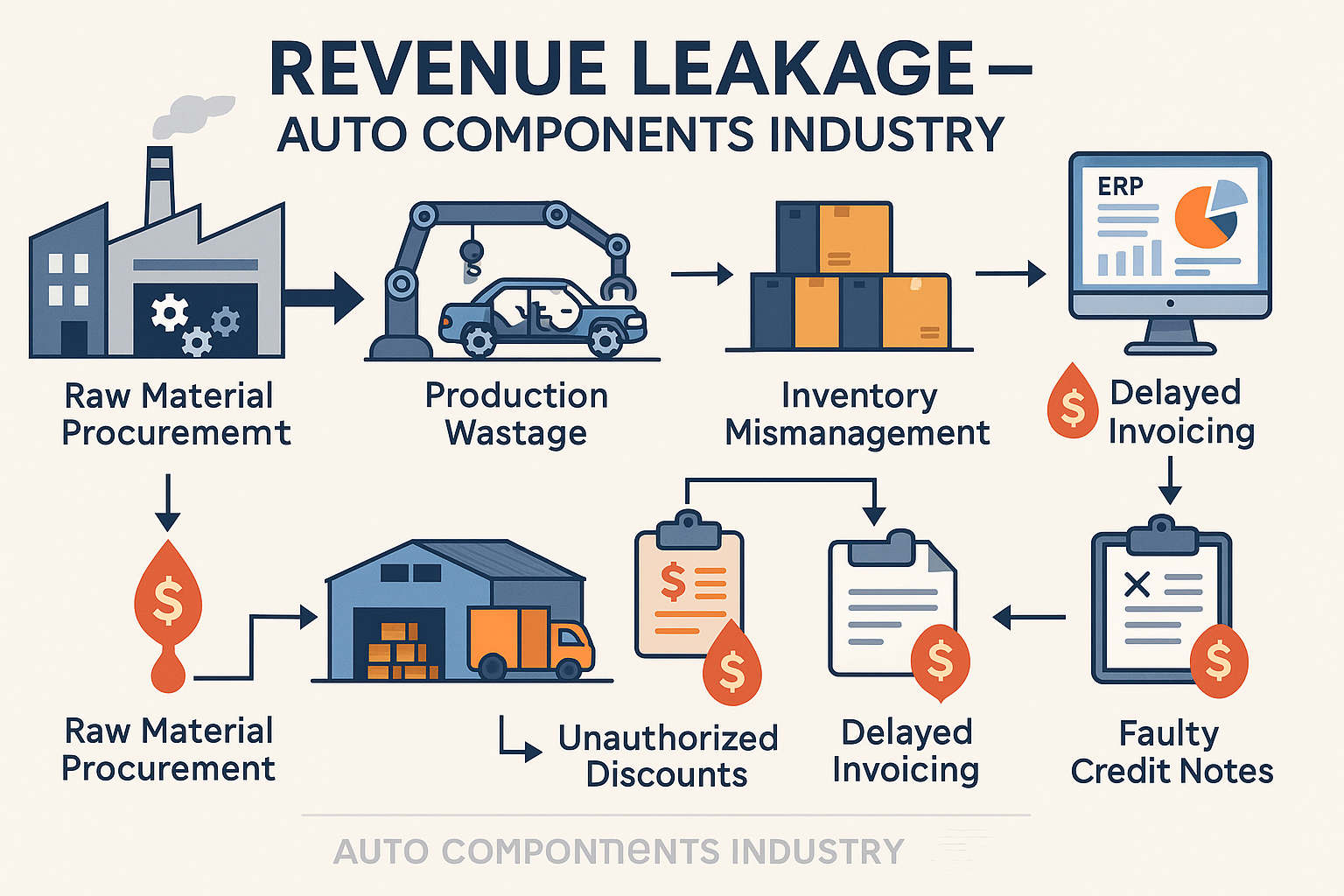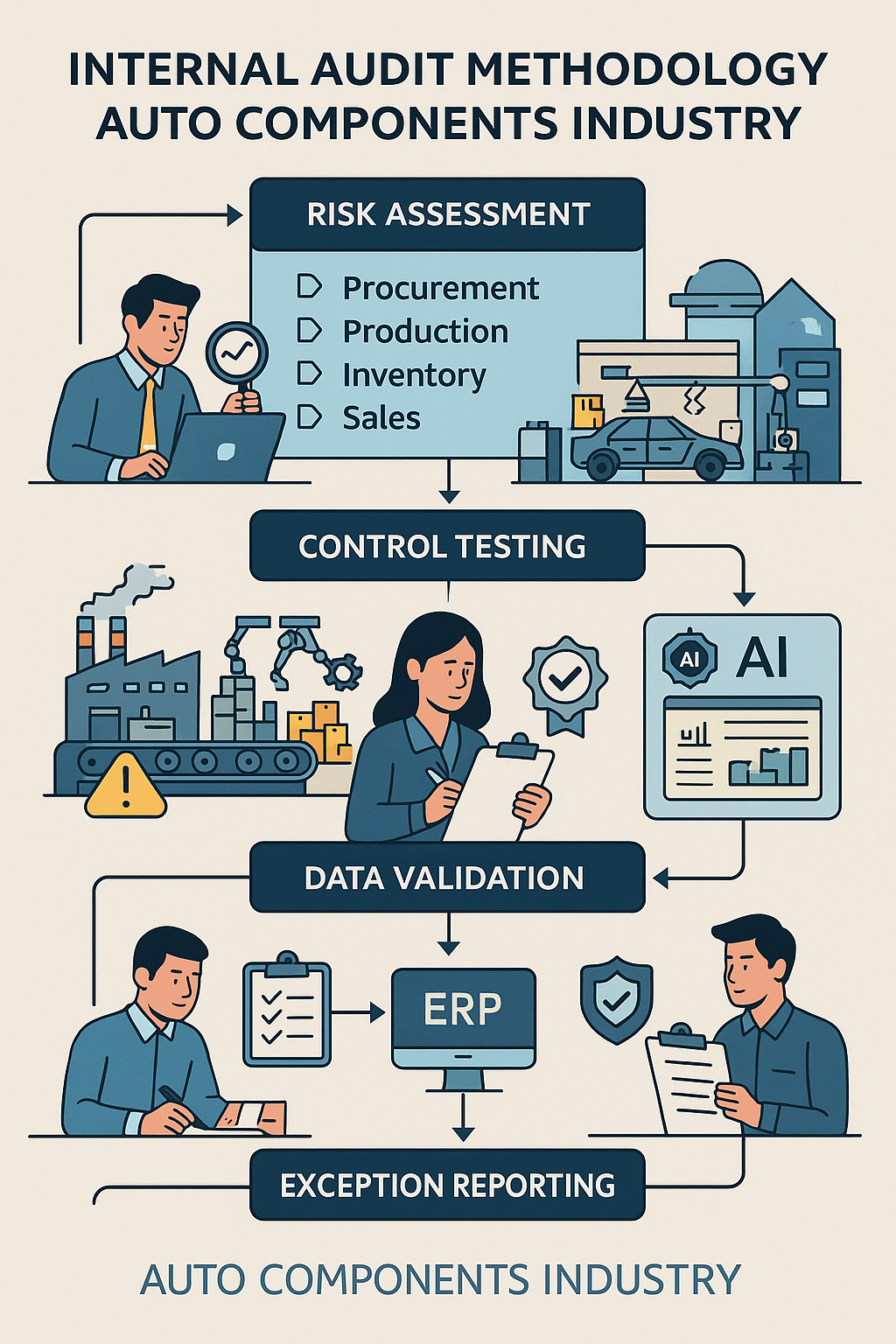Revenue Leakage Detection & Recovery
How our comprehensive internal audit identified ₹8.2 crores in annual revenue leakage for a large manufacturing company and implemented controls to prevent future losses
Client Overview
A leading automobile parts manufacturer with ₹2,400+ crores annual revenue, serving major OEMs across India and exporting to 15+ countries.
Our client, established in 1985, had grown from a small auto-component supplier to one of India's largest manufacturers of precision automotive parts. With 8 manufacturing facilities, over 3,500 employees, and complex multi-tier pricing structures serving 200+ customers, the company suspected revenue leakage but lacked the internal expertise to conduct a comprehensive audit.
The management team approached us after noticing declining profit margins despite stable volumes and pricing. Initial investigations suggested potential issues in their revenue recognition processes, pricing implementations, and billing systems across multiple product lines and customer segments.
₹2,400+ Cr
Annual revenue across all product lines
200+
Active customers with complex pricing tiers
1,500+
SKUs across multiple product categories
Revenue Leakage Indicators
-
Declining Profit Margins
EBITDA dropped 2.3% despite stable volumes
-
Pricing Discrepancies
Manual pricing overrides without proper approvals
-
Billing Delays
Average billing cycle extended to 15 days
-
Revenue Recognition Issues
Potential non-compliance with accounting standards
The Challenge
The manufacturing company faced complex revenue leakage across multiple touchpoints in their sales and billing processes, requiring a systematic audit approach to identify and quantify losses.
Our analysis revealed several critical areas where revenue was being lost:
- Pricing Inconsistencies: Different pricing being applied to similar customers without documented justification, resulting in unintended discounts
- Contract vs. Billing Mismatches: Billing rates not reflecting negotiated contract terms, especially for volume discounts and seasonal adjustments
- Under-billing Issues: Quantity discrepancies between delivery receipts and invoices, leading to unbilled shipments
- Revenue Recognition Timing: Premature or delayed revenue recognition affecting actual earnings and cash flow
- Export Benefits Claims: Unclaimed duty drawbacks and export incentives worth several crores annually
- Credit Note Abuse: Excessive credit notes issued without proper authorization or documentation
- Free Goods Management: Promotional free goods not properly tracked, leading to additional unaccounted giveaways
The complexity was amplified by the company's growth through acquisitions, resulting in disparate systems, processes, and controls across different locations and business units.

2.3%
EBITDA Margin Decline
15 Days
Average Billing Delay
Revenue Risk Assessment
Our Audit Methodology

Risk Assessment & Scoping
We conducted a comprehensive risk assessment to identify high-priority areas:
- Process mapping of order-to-cash cycle across all business units
- Data analytics on 36 months of historical transactions (₹7,200+ crores)
- Identification of high-value, high-volume customer segments
- Risk scoring based on transaction complexity and control environment
- Stakeholder interviews with sales, finance, and operations teams
Data Extraction & Analysis
We deployed advanced data analytics techniques to identify anomalies:
- Extracted data from ERP systems, CRM, and legacy billing systems
- Performed statistical analysis to identify pricing outliers
- Contract vs. billing variance analysis using Python scripts
- Trend analysis to identify systematic revenue leakage patterns
- Benford's Law analysis to detect potential manipulation
Detailed Testing & Investigation
We performed substantive testing on identified risk areas:
- Sample testing of 2,500+ high-value transactions
- Reconciliation of delivery receipts with invoices
- Contract terms verification against billing rates
- Export documentation review for unclaimed benefits
- Credit note approval and justification analysis
Root Cause Analysis & Quantification
We determined underlying causes and quantified financial impact:
- Process gap analysis and control weakness identification
- System limitation assessment affecting revenue accuracy
- Training gap analysis in sales and finance teams
- Quantification of revenue leakage by category and business unit
- Projection of annual impact based on identified patterns
Key Audit Findings
Pricing & Discount Leakage
Systematic under-billing due to pricing inconsistencies and unauthorized discounts.
Key Issues Identified:
- ₹3.2 crores annually: Unauthorized discounts exceeding approved limits
- ₹1.8 crores: Volume discount thresholds not properly monitored
- ₹0.9 crores: Outdated pricing not updated after contract renewals
- 287 customers: Receiving preferential pricing without documentation
- 15% of transactions: Manual pricing overrides without approval
- Lack of price approval workflow in ERP system
Billing & Quantity Discrepancies
Revenue loss due to under-billing, billing delays, and quantity mismatches.
Key Issues Identified:
- ₹1.4 crores: Goods delivered but not invoiced (unbilled revenue)
- ₹0.7 crores: Quantity differences between delivery and invoice
- ₹0.3 crores: Billing delays causing period-end revenue recognition issues
- 142 instances: Delivery receipts not matching invoice quantities
- 8-15 days average: Delay between delivery and billing
- Manual reconciliation processes prone to errors
Export Benefits & Incentives
Unclaimed government benefits and export incentives reducing net realization.
Key Issues Identified:
- ₹2.1 crores: Unclaimed duty drawback for exports
- ₹0.8 crores: MEIS benefits not claimed within time limits
- ₹0.3 crores: Export promotion scheme benefits
- 18 months average: Delay in filing export benefit claims
- Lack of tracking system for export incentive deadlines
- Manual processes causing missed opportunities
Credit Notes & Adjustments
Excessive credit notes and adjustments without proper controls and documentation.
Key Issues Identified:
- ₹1.1 crores: Credit notes issued without proper authorization
- ₹0.6 crores: Duplicate credit notes for same issues
- ₹0.4 crores: Promotional adjustments exceeding approved budgets
- 28% increase: Year-over-year growth in credit note value
- Weak approval controls for credit note processing
- No systematic review of credit note trends
Revenue Leakage Summary
| Leakage Category | Annual Impact (₹ Crores) | % of Total Revenue | Recovery Potential | Risk Level |
|---|---|---|---|---|
| Pricing & Discount Issues | 5.9 | 0.25% | High (90%) | High |
| Billing & Quantity Discrepancies | 2.4 | 0.10% | Medium (70%) | Medium |
| Unclaimed Export Benefits | 3.2 | 0.13% | High (95%) | Low |
| Credit Note & Adjustments | 2.1 | 0.09% | Medium (60%) | Medium |
| Other Miscellaneous Issues | 0.6 | 0.03% | Low (40%) | Low |
| Total Revenue Leakage | 14.2 | 0.59% | Medium-High (80%) | High Impact |
Recovery Actions & Process Improvements
Immediate Recovery Actions (Month 1-2)
Pricing Corrections
- Implemented customer-wise pricing matrix with approval workflows
- Corrected 287 customer pricing discrepancies
- Recovered ₹1.8 crores through billing adjustments for past 6 months
- Established monthly pricing review committee
Export Benefits Claims
- Filed pending duty drawback claims worth ₹2.1 crores
- Submitted MEIS applications for eligible exports
- Created automated tracking system for benefit deadlines
- Assigned dedicated team for export incentive management
Process Improvements (Month 2-4)
Billing Process Enhancement
- Automated delivery-to-billing reconciliation system
- Implemented real-time quantity matching controls
- Reduced billing cycle from 15 days to 3 days
- Created exception reports for billing discrepancies
Credit Note Controls
- Established 3-tier approval matrix for credit notes
- Implemented monthly credit note review process
- Created analytical reports tracking credit note trends
- Reduced unauthorized credit notes by 85%
System & Control Enhancements (Month 4-6)
ERP System Enhancements
- Integrated pricing approval workflow in ERP system
- Automated volume discount calculation and monitoring
- Real-time revenue recognition dashboard
- Exception-based reporting for all revenue transactions
Training & Governance
- Comprehensive training for 120+ sales and finance staff
- Monthly revenue assurance reviews
- KPI dashboard for revenue leakage monitoring
- Quarterly internal audit of revenue processes
Implementation Roadmap & Controls Framework
Revenue Assurance Controls
| Control Type | Frequency | Owner | Status |
|---|---|---|---|
| Pricing Matrix Review | Monthly | Sales Finance | Implemented |
| Billing Accuracy Check | Daily | Operations | Implemented |
| Export Benefits Tracking | Weekly | Export Team | Implemented |
| Credit Note Analysis | Monthly | Finance | Implemented |
| Revenue Assurance Audit | Quarterly | Internal Audit | In Progress |
Technology Solutions Implemented
- Automated Pricing Engine Completed
- Real-time Billing Reconciliation Completed
- Export Benefits Tracker Completed
- Revenue Dashboard Completed
- AI-based Anomaly Detection Phase 2
Results & Business Impact
Revenue Recovery & Protection
₹8.2Cr
Total Annual Revenue Impact
₹4.2Cr
Immediate Recovery
0.34%
Revenue Leakage Percentage
180%
Return on Audit Investment
Comprehensive Business Impact
The revenue leakage audit delivered significant financial and operational improvements:
Financial Recovery & Protection
Recovered ₹4.2 crores in immediate revenue adjustments and identified ₹8.2+ crores in annual revenue protection. The audit investment of ₹45 lakhs generated an ROI of 180% in the first year alone.
Process & Control Enhancement
Implemented robust revenue assurance controls reducing future leakage risk by 85%. Automated systems now prevent pricing errors and ensure timely billing, with 99.7% billing accuracy achieved.
Operational Efficiency
Reduced billing cycle time from 15 days to 3 days, improved export benefits realization by 95%, and enhanced pricing accuracy across all customer segments. Finance team efficiency improved by 40%.
Organizational Capability Building
Trained 120+ employees on revenue assurance practices, established quarterly audit protocols, and created a revenue governance framework that scales with business growth.
Before vs. After Comparison
| Metric | Before Audit | After Implementation | Improvement | Status |
|---|---|---|---|---|
| Revenue Leakage (Annual) | ₹14.2 crores | ₹2.1 crores | 85% reduction | Excellent |
| Billing Accuracy | 94.2% | 99.7% | 5.8% improvement | Excellent |
| Average Billing Cycle | 15 days | 3 days | 80% reduction | Excellent |
| Pricing Compliance | 73% | 98% | 34% improvement | Excellent |
| Export Benefits Realization | 65% | 95% | 46% improvement | Excellent |
| Credit Note Control | Poor | Strong | 85% fewer unauthorized notes | Excellent |
| Revenue Recognition Compliance | 78% | 99% | 27% improvement | Excellent |
Revenue Assurance Monitoring Dashboard
Post-implementation, we established a comprehensive monitoring framework to ensure sustained revenue protection and early detection of potential leakage.
Monthly Revenue Leakage Trends
Current Month KPIs
Revenue Leakage
0.09%
Target: <0.15%Billing Accuracy
99.7%
Target: >99%Avg. Billing Cycle
2.8 days
Target: <5 daysExport Benefits
94%
Target: >90%Real-time Monitoring Alerts
Pricing Compliance
All clear - No pricing deviations detected
Billing Queue
Normal - 12 items pending (within SLA)
Export Benefits
3 applications due this week
Credit Notes
Within normal limits - 8 pending approvals
The revenue leakage audit conducted by Sompalli & Co was truly eye-opening. We knew we had some inefficiencies, but the systematic approach they took uncovered ₹8.2 crores in annual revenue impact that we weren't even aware of. More importantly, they didn't just identify the problems - they helped us implement sustainable solutions. The pricing controls, automated billing reconciliation, and export benefits tracking systems they recommended have transformed our revenue assurance capabilities. Six months later, we're still seeing the benefits with continued revenue protection and much stronger financial controls. This audit has been one of our best investments.
6-Month Implementation Timeline
Phase 1: Assessment & Analysis
Month 1
- Data extraction & analysis
- Process mapping
- Risk assessment
- Initial findings report
Phase 2: Detailed Investigation
Month 2
- Sample testing
- Root cause analysis
- Quantification of losses
- Recovery opportunities
Phase 3: Immediate Recovery
Month 3
- Pricing corrections
- Export benefit claims
- Billing adjustments
- Quick wins implementation
Phase 4: Process Design
Month 4
- Control framework design
- System enhancements
- Workflow automation
- Training material development
Phase 5: Implementation
Month 5
- System implementation
- Staff training
- Pilot testing
- Process refinement
Phase 6: Monitoring & Handover
Month 6
- Dashboard setup
- Monitoring protocols
- Knowledge transfer
- Final documentation
Protect Your Revenue with Professional Internal Audit
Is your organization experiencing unexplained margin pressure? Let our experienced team conduct a comprehensive revenue leakage audit to identify and recover lost revenue.